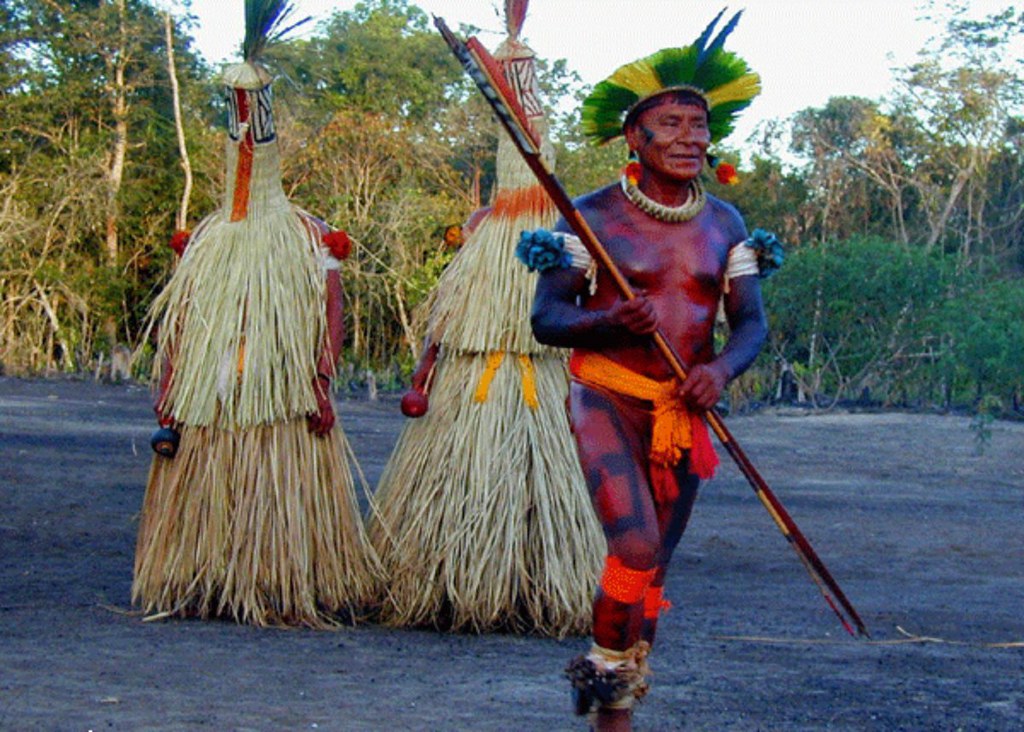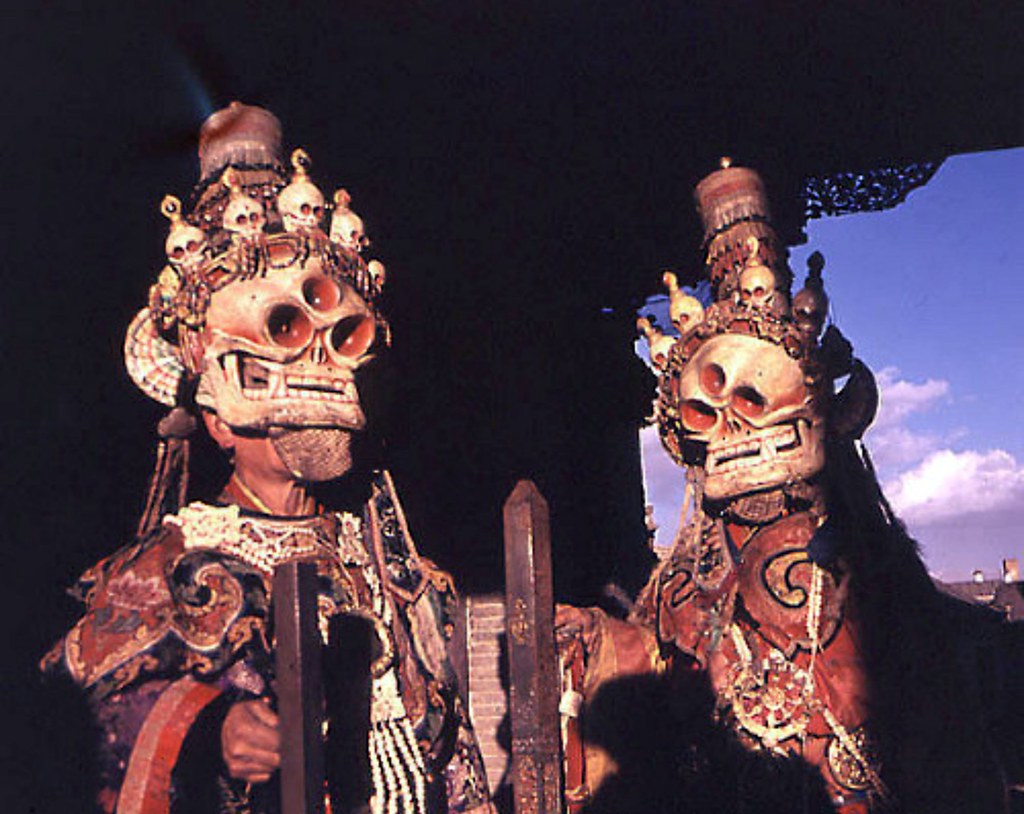Bamileke elephant masks
Elephants are the world's most commanding land creatures, unsurpassed in grandeur and power. Thus elephant masks, while rare in Africa,
are fully appropriate symbols of important leaders or, at least, their respected deputies or messengers. The societies that use these masks
in fact act as agents of chiefs' control and as formal royal emissaries. Elephant societies that originated in Bamileke and spread elsewhere
in the Grasslands consist of three graded ranks attained by wealth. These elephant masks, signifying kingship and wealth, were worn by the
powerful members of the Kuosi regulatory society, which included members of royalty, wealthy title holders, and ranking warriors of the
Bandjoun kingdom of western Cameroon.
In the past, payment of a slave or a leopard pelt to the chief who owns the society was necessary for entrance to the highest rank. The
glass beads used on earlier masks were nineteenth-century trade beads of Venetian or Czechoslovakian manufacture, used as well in
exchange for slaves. Elephant mask costumes were thus called "things of money" since their beads were both objects and symbols of wealth
(Brain and Pollock 1971:100; Northern 1975:17-21).
Elephant masks comprise cloth panels and hoods woven from plantain fiber over raffia. On this background multicolored beads are stitched
in geometric patterns. The basic form depicts salient features of the elephant—a long trunk and large ears. The hood fits tightly over the
masker's head, and two hanging panels, one behind and one in front, partially conceal the body. The front panel is the elephant trunk, and
the two large, stiff circles hinged to either side of the head are its ears, which flap as the masker dances. While the mask symbolizes an
elephant, the face is human. Eyeholes provide visibility, and a nose and mouth with teeth are normally present.
Such masks are often worn with robes of dark woven fiber covered with small fiber knobs or indigo and white tie-dyed "royal" cloth. The
robes contrast greatly with the maskers' bright red legs, dyed with camwood. Costumes also include beaded vests with broad belts and
leopard pelts attached at the back. Since a chief owns or controls the masking society, both leopards and elephants are apt metaphors for
symbolic impersonation.
Maskers dance barefoot in these colorful costumes to a drum and gong, moving slowly as they wave poles with blue and white beaded tips
trimmed with horsehair. They whistle "mysteriously and tunelessly," brandishing spears and horsetails. Maskers are later joined by chiefs
and princesses, parading by an elaborate tent in which high-ranking men sit to observe. A masker hurls his horsetail to the chief, the crowd
cheers, and the celebration continues with various feats performed primarily by younger maskers. When the festivities end, the favorites are
rewarded with kola nuts and wine (Brain and Pollock 1971:100-104; Northern 1975:17).
The beauty of these masks is largely in their colorful beaded patterns. Dark blue or red backgrounds provide foundations for basic
geometric designs laid out in white, creating a striking contrast. As Tamara Northern indicates, the masks show varied degrees of order and
complexity (1975:116).33 Masks may be sparsely or densely beaded.
The mask's lavish use of colored beads and cowrie shells displayed the wealth of the members of the Kuosi society; and its colors and
patterns expressed the society's cosmic and political functions. Cowrie shells are also symbols of wealth and power and were used in
the some examples of these masks.
Black denotes the relationship between the living and the dead. White refers to the ancestors and potent medicines. Red symbolizes life,
women, and the institution of kingship. The dominant triangle designs on both masks represent leopard spots, the leopard being a royal
symbol of power and mastery like the elephant. The members of the Kuosi regulatory society belonged to the royal court and enforced the
laws of the kingdom in all spheres of life. The society gathered together during funeral ceremonies of its members and for public
celebrations of kingship to display the Bandjoun kingdom's power and wealth.
Source- Sign of the Leopard; Beaded Art from Cameroon
Bamileke cowrie shell elephant mask.
An older piece in my opinion.
50" tall
Click on any picture to see larger version.
The photo on the left is an example of the way I used to take photos, the photo on the right is with my new system. They still aren't perfect,
but the quality is much better and it's a big improvement.
Red feather headdress- red/orange feather headdress which sits on the top of the embroidered fabric Cameroon elephant masks.
Used in tribal funerary ceremonies. Each feather quill is encased in a black silky fabric (on the reverse side). Inverts onto itself to
form a 13 inch high bundle with 11 1/2 inches across the bottom. Bottom has a leather loop and a coarse rattan type finish (similar
to Kuba textiles). Size: 29 inches across x 9 inches high.
Beaded flywhisk with horse hair.
These objects were used in conjunction with the elephant masks.
The king and Kuosi society members in Bandjoun 1930
Cameroon elephant maskers in the Bamenda highlands (Nsaw group).
Photo: Paul Gebauer, 1930s
Bamileke Kuosi elephant masqueraders
in full costume
GRASSLAND, Cameroon
The northern part of Cameroon has been Islamized and has no sculpture; on the other hand, the savannas of the west, the
Grassland, are composed of three ethnic groups with ancestors in common. There are the one million Bamileke spread
over the southwestern plateaus, in communities that have from 50,000 to 100,000 people; the 500,000 Bamenda-Tikar in
the north; and, finally, the Bamum in the northwest, with a population of 80,000. The Bamileke resisting slave raids with
suicide or rebellion, contributed very little to the Black population of the New World. The artistic production of the people
living in the Grassland of Cameroon is closely associated with royal and societal ceremonies. Large figures, thrones and
prestige paraphernalia are used by the king to assert his power.
The Grassland was divided into ninety kingdoms governed by a king, the fon, supported by non-secret societies. In the
past, he was believed to be endowed with supernatural powers that allowed him to change into an animal – an elephant,
leopard, or buffalo. He ensured the protection of his people and guaranteed the fertility of the fields and the fecundity of
the women. The fon was responsible for rituals of planting and harvesting, for the annual festival of the dry season, for the
opening of the collective royal hunt, and for expeditions of war. The fon was appointed by his predecessor, who chose him
from among his direct heirs, excluding the eldest. Art objects were symbols of position in the hierarchy; their number, the
materials from which they were made, and their iconography changed progressively as one descended or ascended the
social ladder. Competition among sculptors was often great, for the artist’s “office” was not hereditary. Sculpture’s goal was
to commemorate and celebrate the royal ancestors of the present fon. In the fon’s palace, next to the ancestral figures and
the masks, one would also find headdresses, beaded thrones, bracelets, necklaces, pipes, leopard skins, elephant tusks,
swords, commanders’ sticks, fans, dishware, horns, and terracotta bowls.
In Bamileke territories, the fon entrusted the guardianship of the sculptures to certain members, for to spread around
portions of the treasury was an insurance against the frequent fires. Masks that elicit fear and apprehension are the work
of societies responsible for repression. In spite of the ethnic and stylistic variations found in the Grassland area, similar
types of mask have been produced. All young boys belong to associations based on age classes, covering periods of five
years each, focusing on military and technical apprenticeship. The various societies also had their masks; some of them,
according the tradition, had been created and consecrated by the ancestors themselves, others inspired great fear, there
were masks decorated with beads, copper, and cowrie shells. Most of the kingdoms used the buffalo, stag, elephant, birds
masks, and masks presenting male and female human heads. They are usually worn during state ceremonies such as the
funeral of an important dignitary, or during annual festivities. During these ceremonies, the leading dancer wears a n’kang
mask which bears a false beard, a coiffure split in two symmetrical parts and is often covered in royal paraphernalia such
as cowrie shells and beads. The n’kang mask is followed by other masks representing a woman, a man or an animal. The
buffalo and elephant masks represented strength and power, and the spider mask, intelligence, but most of the meanings
are now lost.
Bamum social life was oriented toward the conquest of surrounding chieftainries, and forays were made into neighboring
lands: from this stems a warrior mythology and an abundance of material symbols of strength. The Bamum produced large
figures encrusted with beads and cowries. Noteworthy elephant heads cast in bronze. There are also: dance masks in the
form of a long head and a high neck, also in animal-head form; footstools and thrones decorated and supported by animal
or human figures. In the small kingdom of Bangwa, the heads of statues and masks feature puffed-out cheeks. The very
characteristic sculpture in the round attains its apogee in a depiction of a horn-player who wears traditional headgear in the
shape of a tiara; the thick double arc of his eyebrows overhang, and the mouth is treated in parallelepipedal relief under a
heavy nose featuring well-shaped nostrils.
The wood used for masks is not always completely hollowed out, for the mask does not cover the face of the wearer but
rather tops a kind of bamboo cage surrounded by a tufted collar of palm fibers, which conceals the head. These masks,
instruments of societies with political, administrative, judicial, or theatrical functions, were kept in special storage houses;
they were brought out at the first rainfall. Then, the king himself would appear masked and dancing. The buffalo joins the
leopard, elephant, and two-headed python as an image of royal power is frequently found in the decoration of works from
the region.
A large number of prestigious items of paraphernalia were produced within the Grassland area, including large house-
posts, door and window frames carved with human and animal figures, thrones, stools and tables decorated with small
heads and figures, large bowls, carved horns for royal feasts, anthropomorphic terracotta and bronze pipes. Musical
instruments such as anthropomorphic and zoomorphic drums, as well as metal gongs, were played during royal and state
ceremonies.
Source: www.zyama.com
Main Menu
Go to the Bamileke beaded elephant mask page
Go to the Bamileke elephant/leopard headcrest page
Click here to go to Grasslands page


